Hunting Canada Geese Tips and Tactics
Decoying Canada Geese
by B.C. Maxima
A Five Part Mini-Series
- Overview: What It Takes To Be Successful
- Location: Finding the Perfect Field
- Concealment: Get Down And Cover Up
- Decoys and Calling: The Hard Facts
- The Hunt: Tying It Together
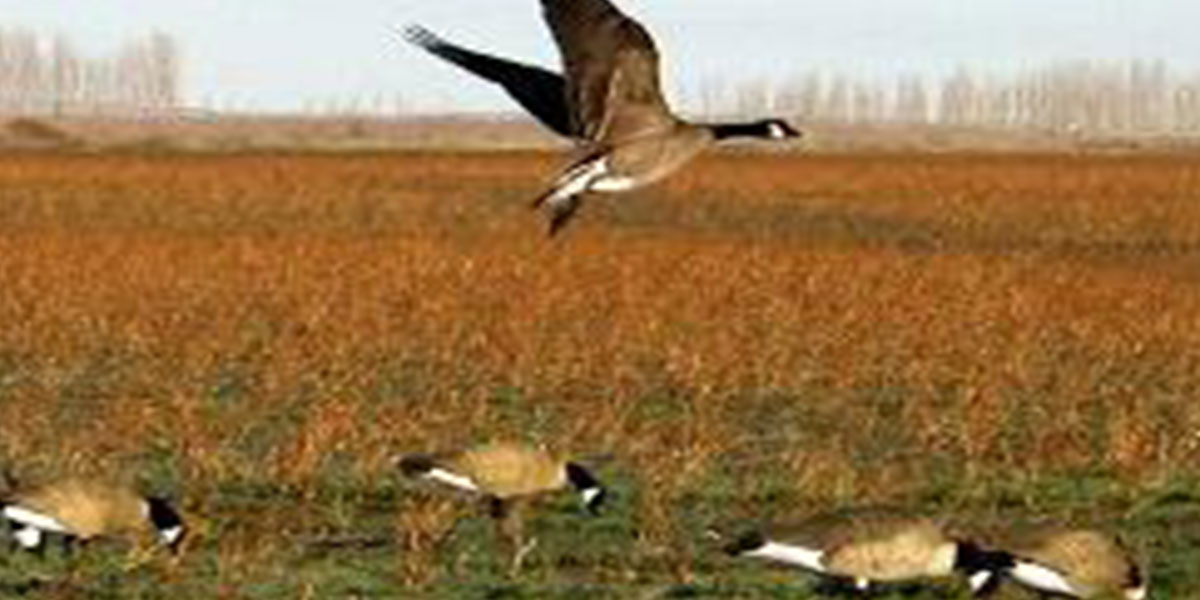
Part 5 The Hunt: Tieing it all together!
It is the beginning of September and the Early Canada Goose Season opens tomorrow. We have been scouting for the past three weeks and have permission to hunt on several fields for the early season. Two of them have had geese using them regularly but one of them had 200 honkers sitting on it last night. That is our money field. So we make all of the necessary preparations the day before. We have scouted the field to make sure that the geese are still using it as well as knowing the exact spot they have been sitting (which is very important). We have a nice spread of 40 full body goose decoys packed into our trailer along with four ground blinds, one for each of us. We are set to go! The alarm goes off at 4:30 a.m. giving us ample time to get to the field and set up before our feathered friends arrive. Everyone is packed up and off we go, we get to the field at 5:30 only to find two sets of headlights out in our field! That sinking feeling in the pit of your stomach starts to burn….
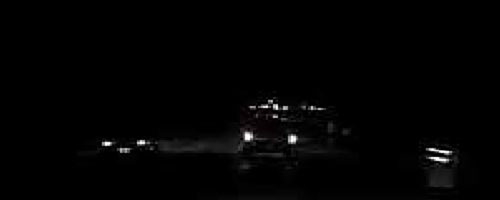
In this article we will be dealing with situations that arrive such as this one, we will be detailing exactly what needs to be done to be successful during our hunt and we will be adding some additional tips throughout the article, that we did not have time to address in our previous articles.
Overcoming Complications
So we have arrived in our field on opening day only to find two trucks, full of hunters already setting up. But wait, we contacted the farmer two days ago and he said that we were going to be the only ones hunting there today, what happened?
Well the first thing we need to do is talk to these guys and find out what happened. Do not be intimidated to speak with other hunters, maybe there has been a miscommunication or a mistake made that needs to be clarified. In further investigation we come to find that the farmer’s brother pulled into town late last night with a rig full of decoys and hunters and expected to be able to use our field. But our farmer friend hasn’t completely forgotten about us. Our arrangement has been explained and we are invited to join our six new found friends and since there are over 200 geese in this field, there should be plenty for everybody right…
Now is when each individual group needs to make there own decisions. The field is not big enough to split up and we definitely do not want to cause any major problems with this farmer for the future. In this particular situation, which will come up eventually during your hunting career, you need to be prepared. Personally I would rather not participate in a hunt with six strangers since I do not know there hunting style and safety levels. I also do not enjoy hunting in groups of ten hunters. That being said maybe your group has no problem with that and you have an opportunity to make some new friends. That decision is up to you. But all is not lost, because we have a back up plan! This is why it is so very important to have several options and permission to hunt more than one location. We still have that field that has had geese on it regularly for the past month and even though we did not see them last night it is probably our best bet. I would however take note to the names of our new friends and what make and color their vehicles are to follow up on with our farmer friend when the hunt is over. We don’t want to make any waves but we do want to verify that Joey is actually the farmer’s brother and he did have permission to hunt our field.
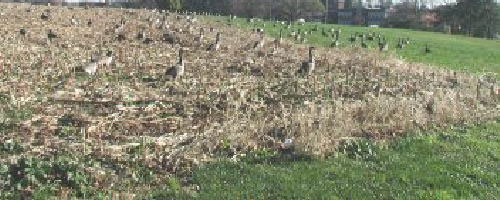
Setting Up
So off we go to field number two. We are running late now after our conversation and added drive time so we need to be proficient in getting set up. It is very frustrating watching flock after flock try and land in our spread when the trucks are still out there.
The first thing we need to do is pick out the spot where the birds have been feeding. In the dark it can get a little disorientating trying to find that exact spot where the geese have been sitting. One good tip is to pound a stake in the ground the evening before, after the geese leave as a marking point. But since this is our second option we need to make the best of it. Looking for fresh feathers and droppings is our best bet. The second step is to unload the trailer and start throwing out decoys as fast as we can since we’re in a rush, right… Absolutely Not! Our next step is to get the blinds set up and ready to go along with getting all of our gear into them ready to hunt. The reason I recommend setting the blinds up before the decoys is that a lot of times after the decoys are set and we are trying to find a spot to put our blinds up, we end up all over the place since the decoys did not get set up perfectly to hide everyone. So to make it easier and to save time let’s set the blinds up first, then put everything we need into them so we don’t forget anything in our mad rush out of the field with the trucks. Let me take a second here as well, after everything we have done in preparation for the hunt do not get lazy here. When hiding the trucks make sure they are completely out of site, especially from the direction the birds will be coming from. Even if it means walking an extra 400 yards, get those trucks out of site!
Now, we have already determined that our best bet is to place all four blinds in a row about 5 – 7 yards apart with our backs to the wind. Now for the next predetermined decision that is critical to our success today. Who is going to be our Field Captain? We need to have elected the guy who has the most experience and is a good caller to “Call the Shot” when the birds arrive.
The reason it is so important to have a field captain is that many times the birds will swing once, twice, and then leave. Then everybody is arguing why didn’t you shoot or I was going to shoot but I didn’t want to screw it up for everybody else or the biggest excuse, I thought they were going to swing one more time. The novice hunter does not know what the birds are going to do and nor should he be expected to decide that for himself. Experienced hunters have learned to decipher if the birds are going to make one more pass or if this is it and we need to take the birds at 30 yards.
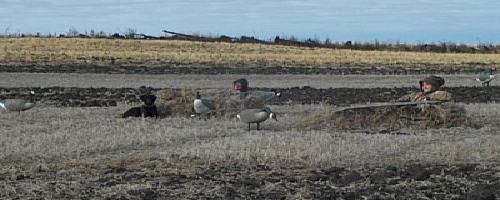
Now that we have our field captain set for the day, sitting in the middle, we can proceed to get our spread set up. I recommend getting all of the decoys out of the trailer, doing one last double check on gear and then send the trucks out while the other two guys start setting up the spread. I also find it beneficial to only have two guys set up the decoys because when three or four guys set out a spread, one guy does not understand what the final product is supposed to be and it actually makes more work in the end. One way around that is to have a third guy follow one of our setters, just to help carry decoys.
So what is our spread supposed to look like anyway? Well since we are hunting early birds, as stated in the previous article, we are going to set up groups of 7 to 10 decoys in small family groups spaced out about 15 to 20 yards apart. We will also be placing a larger group right around the main area where our blinds are set up to break up there silhouettes. One last thing I like to do is place several sentry decoys ten yards out in front of the spread to emulate several birds that have just landed and are walking up into the main flock. These should be our best looking decoys since they are the ones the birds will be keying in on the most.
The Hunt
Now we are completely set up and just in time, as we start to hear geese coming from across the field. Ideally we will have two guys calling and two guys flagging. It is possible to do both but it is easier to do one thing well. We start flagging and calling as soon as we see the geese. We are not going to stop flagging or calling until we shoot or the birds are gone. However the time in between is very critical obviously. Our flaggers need to know how to flag and that is an art in itself. So it is important for the more experienced flaggers to show the new guys what to do. Now our callers also need to know what to say and when. One big misconception on calling geese is that when we start calling we want to call loud and obnoxiously and when the geese get close we want to get soft and finally shut up completely. This is actually the opposite of what we are trying to accomplish.
We do need to be loud off the bat to get there attention but as the geese get closer we can start to be more realistic and cut back a little. However at the end, when we are closing the deal, to shut up completely is actually a deal killer!! The only time geese actually shut up on the ground is when there is something wrong. We want to incorporate some lay down calls with some sharp clucks towards the end because when the geese are landing, the birds on the ground are not saying come in and have a bite to eat, they are actually saying stay away from me I am protecting my food and they can get very aggressive.
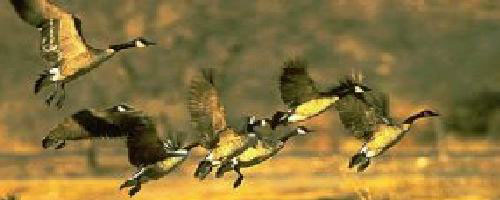
So the geese are coming in like B-52s just like we pictured. Our captain gives the call and we open up on them. Five birds hit the ground and four slip away. Everybody is excited and jumps up as we have finally got to clear the rust out of the barrels from last year and we actually hit something. Geese are flopping around on the ground and everybody is happy. But here is another missed opportunity. This flock of nine geese was a family group and we just shot mom and dad, what are these kids thinking that are flying away? They have no idea what just happened and they are confused. If everybody would stay in there blinds and reload while our callers get back on these birds with a comeback call, there is a good chance these birds will come back again. Now they may not land in the decoys and our “Captain” is going to have to know at what range we need to open up again vs. shooting at birds that are out of range, but there is no reason why these birds cannot be called back again two or three times, especially with our live decoys on the ground flopping around.
In conclusion, I hope that this mini series of articles on Decoying Canada Geese has been helpful and that this article in particular has given some useful advice on how to prepare yourself for the hunt and what to do when different situations arise as well as to help clear up some misconceptions on goose hunting in general. The best advice is to try and be prepared for any situation that arises. For the most part windshield time and experience can clear up most any situation. The bottom line is get out there and hunt! Do not be afraid to try new ideas and go by yourself if nobody else can make it out that day. The only way to really learn the patterns of geese and techniques of goose hunting is to make mistakes try again and again and have fun doing it! Good luck this upcoming fall and Take A Kid Hunting!
Be sure to check back next month for our next article on “Picking The Perfect Rifle” by Mike Moen.
For additional articles please review
- “Planning For Next Season” by Mike Moen
- “The Perfect Rifle” by Mike Moen
- “Magnumitis” by Mike Moen
